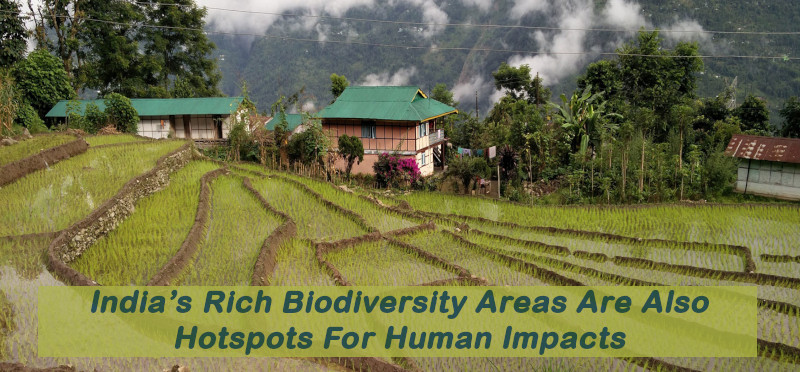
In a study, it was found that the biodiversity rich “hotspots in the country” are also the areas where the human impacts is the highest.
The Study :
- The study by a team of researchers from the University of Queensland found that the southeast asian forests that include India’s Himalayas, Western Ghats, and the north-east region are adversely impacted by human activities.
- These areas are biodiversity hotspots of threatened species.
- In total 84% of the species on earth surface are impacted by human activities.
- For the study, the researchers mapped eight human activities which includes hunting and converting the forest land for agriculture.
- They have covered areas of 5457 threatened species of birds, amphibians and mammals across the world.
The Findings :
- Using various sources including the Human Footprint data, the researchers found that 1237 species faced 90% threats to their habitat, 395 species faced threats across their range.
- Roads have the highest impact with 72% of terrestrial areas being affected by them.
- Crop lands affected the largest number of species – 3834.
- While Malaysia ranks first with 125 species being affected by human impacts, India stood at 16th with 35 species on average.
- In India, 60 species are impacted on the south western ghats montane rain forests and 53 in Himalayan subtropical broad-leaf forests.
Also Check: A National Mission to Promote Transformative Mobility have been Launched
Solace :
- The study also pointed out that these spots are also cool spots which means these are the last refuges on earth with high number of threatened species.
- As per the researchers, cool spots may be due to the presence of still intact habitats for many species or protection provided to these places.
- They say that there are still some places to be protected in India.
- The information provided by the study will help in development planning which can minimise the impact on biodiversity.
Also Check: All About Election Commission of India’s Model Code of Conduct
Conclusion :
- India has the second largest network of roads in the world and is still expanding. Keeping in mind the threat posed by roads to the biodiversity, proper planning needs to be done.
- Already, roads of the country have fragmented many wildlife corridors making movement of animals difficult. This is especially seen with elephants.
- Lack of proper corridors for them to migrate, they are entering human habitations and are leading to man-animal conflict.
- The study came at a right time, where governments world over are diluting environmental laws in the name of development.
- As the study argues, there is no need for seeing development in wildlife areas critically but only changes need to be taken in cropping patterns, road construction etc., to minimise the impact on local biodiversity.
Some Facts :
Biodiversity Hotspot – It is a biogeographical region with abundance of biodiversity but are threatened with destruction. The status is designated by Conservation International. There are 34 hotspots world over.
The criteria for declaring a region as a biodiversity hotspot is: It must contain 0.5% or 1500 vascular plant species as endemic to the region and have lost 70% of its primary vegetation.
Conservation International – It is a non-profit environmental organisation based in USA. The focus areas of the organisation is in fresh water security, climate change, health, food security, cultural services and biodiversity.
Tags: Best IAS Coaching in Delhi | IAS Mock Interview | Best Civil Service Coaching Delhi | Best UPSC Coaching Online | Top Online IAS Coaching In Delhi | Best IAS Institute In Delhi | Online UPSC Coaching

Leave a Reply
You must be logged in to post a comment.